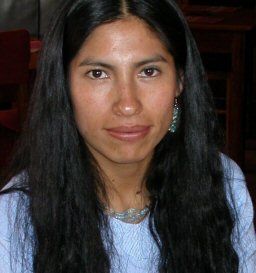Spanish tutorial: Meet My Tandem, Mariarosa Holgado Vargas

Note: This Spanish tutorial page is part of a series of blogs that we wrote while attending one of the language learning programs in Peru. This blog focuses on tandem language learning strategies. These blogs are designed to give you ideas that to implement Walkabout language learning into other language learning programs. Use our examples here for any language you want to learn. See the "More Peru Stories" list of links on this page for additional language learning strategies. Also see our Learn Spanish section.
 Meet my tandem, Mariarosa
Meet my tandem, MariarosaTerry Marshall
In addition to taking formal classes, I'm taking advantage of a special Spanish tutorial. Our language school, Maximo Nivel, offers a valuable supplement to the traditional curriculum: tandem language learning. Because it runs a large English program for Peruvians, Maximo Nivel is set up perfectly to match English- and Spanish-language learners for impromptu, out-of-class practical language practice. It's called tandem language learning and is a way to create a custom-made Spanish tutorial. Learn how to get the most out of your tandem.
The concept is simple: we students work on our own with a native speaker in our target language. Together, we teach each other, setting our own schedule, our own goals, our own methodology. No one pays; everyone benefits. This approach is not uncommon among the language learning programs here.
I meet every day for an hour of tandem language learning with a young architect, Mariarosa Holgado Vargas. She's providing me with a Spanish tutorial, and I'm helping her learn English. Students can tailor their tandem language learning sessions to meet their unique needs and interests. Ann is working with travel agent, Juan, who needs to improve his English for his job. The danger in these unstructured arrangements, of course, is that it's easy to fall into meandering chit-chat – some may feel good because they're speaking in their target language with "a native," content to skim the surface, rather than focus in on serious language learning. Not so Mariarosa and I. We're goal-oriented, both of us. Every day's hour – or hour and a half-plus – is a hard-nosed working English and Spanish tutorial, as intense as any class.
More Peru Stories
Intensive Spanish
Mariarosa is the kind of mentor I wrote about in Whole World Guide. Smart. Witty. Hard-working. Quick. Did I mention intense? She even makes me turn in written homework.
My Spanish Tutorial
Each tandem language learning pair is unique, and anyone interested in learning a foreign language can do it. Here’s how ours work:
- I speak Spanish to Mariarosa. She speaks English to me. We correct each other, using the ongoing conversations as fodder for short drills on specific errors. (Click here for an example of the 3-minute drill.)
- Her formal studies have given her a strong base in grammar and writing, but little practice in speaking, so I've asked her to keep a diary in English. She’s comfortable with it, and good at it. She doesn't hesitate to write about things meaningful to her – her breakup with a longtime boyfriend, for instance, and the recent death of her father. Because she ponders serious thoughts and painful emotions, as well as recounts day-to-day activities, the diary opens us to a wide range of English constructions to work on.
- I correct the grammar in her diary, press her on her thoughts, suggest other ways she might express herself in English, and push her to dig more deeply for details – and the language needed to express them. Additionally, I ask her to tell me orally what she's written, using her stories as grist for work on pronunciation and grammatical usages she hasn't mastered. In short, the diary opens us to both written and spoken practice.
- This week I'm laboring over a thank you note to Mariarosa's friend Chela, a jewelry vendor with whom I spent a delightful afternoon in Machu Picchu. This self crafted Spanish tutorial gives me good practice in my weakest area, writing.
- I'm also focusing on different forms of Spanish past tense by telling her about my weekends. She uses my stories to drill me on correcting persistent errors.
- We end each tandem language learning session by agreeing on what we'll bring to tomorrow's session, initiating the first steps of the daily learning cycle: Plan → Prepare → Practice. This way we come together with a clear agenda (though we do keep ourselves open to changing it depending upon what each of us did the previous night or other thoughts on our minds).
October 31 update: Ann, Shawn and I leave Cusco tomorrow for ten days of Peru travel before we go back to the States. Over these past two weeks, Mariarosa and I have greatly broadened the environment of our daily work sessions. Initially we met at the school. Now, we meet at Mariarosa's office (she owns her own architectural firm). In the spirit of Walkabout Language Learning™, we've also gone to a café on the plaza for snacks and conversation, and today, we had a long, convivial lunch that included Shawn, and Ann and her tandem language learning mentor, Juan.
Over these weeks, we've expanded our tandem Spanish tutorial to conversations about our families, our friends, and our futures. She hopes to get a master's degree in architecture in the U.S. and I'm encouraging her to apply to Yale because of a shared interest in Machu Picchu. Yale's Peabody Museum has a huge collection of artifacts from Machu Picchu – more than 4,000 items – and long-term plans in Peru. (Hiram Bingham, then a Yale professor, re-discovered Machu Picchu in 1911. Bingham mounted expeditions to Machu Picchu in 1912 and 1913 to excavate the site. Clearly, he didn't return to Yale empty-handed.)
For her senior project, Mariarosa designed an intriguing new cultural center in Aguas Calientes at the base of Machu Picchu. In 2010, after a custody battle, the university signed an agreement with the government of Peru both to begin returning the items and to build a Machu Picchu museum in Cusco. Perhaps another tandem language learning opportunity would be mutually beneficial at Yale?
If you don't know a native speaker who's read to start a tandem, but you still want to get started learning a new language, try signing up with a professional language tutor.
If you are ready for specific instructions on how to work with a language learning partner to create your own program, check out the Walkabout Language Learning Action Guide. It shows you step by step how to create your own practical dialogs with the help of a local mentor. Click here to download it today.
Language Learning Programs
- Master the art of the three-minute drill
- Spice up your tandem language learning sessions with your journal or diary
- Use the old-fashioned thank you note for language practice
--Posted by Terry, October 16
← Previous: Top Life Experiences Next: Learn Spanish Grammar →
Return from Spanish Tutorial to Language Lore
Return to Your Language Guide home
Stay in Touch with Language Lore ezine
Want to stay in touch? Subscribe to Language Lore, our internet language learning email newsletter. This free ezine facilitates your language learning journey. See our back issues here.
Go to your email now to confirmation your subscription. If you don't see an email within an hour (check your junk mail folder too), please contact us. We respect your privacy and never sell or rent our subscriber lists. If you want to get off this list later, one click unsubscribes you.
New! Comments
Have your say about what you just read! Leave me a comment in the box below.